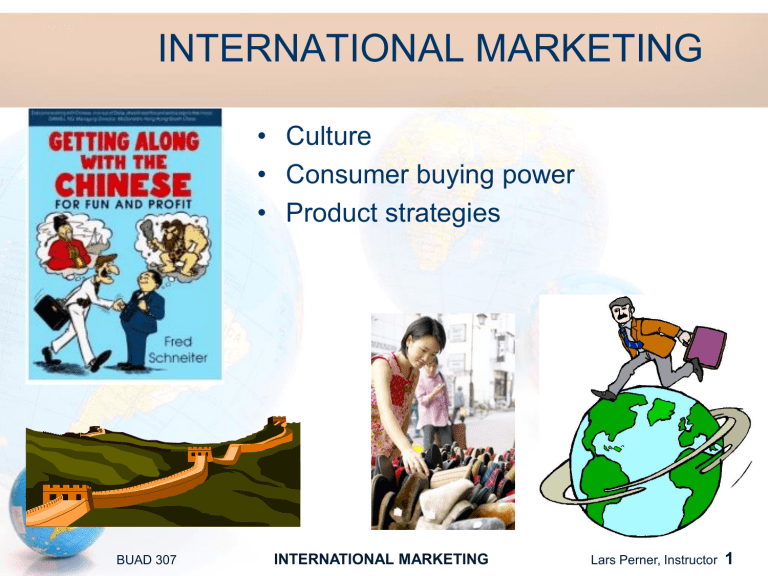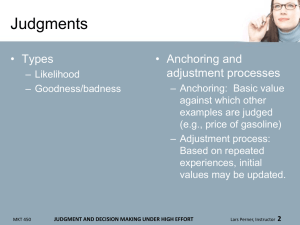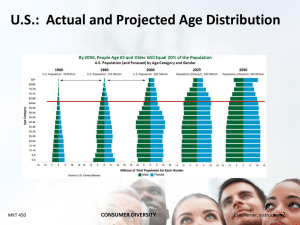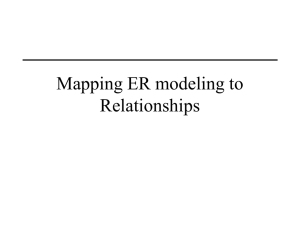International Marketing

INTERNATIONAL MARKETING
• Culture
• Consumer buying power
• Product strategies
BUAD 307 INTERNATIONAL MARKETING Lars Perner, Instructor
1
An Effective Billboard Advertisement?
VERY
DIRTY
CLOTHES
CLOTHES GETS
WASHED WITH
THE
ADVERTISED
DETERGENT
BRAND
SQUEEKY
CLEAN
CLOTHES
BUAD 307 INTERNATIONAL MARKETING Lars Perner, Instructor
2
LEARNING OUTCOME OBJECTIVES
• Appreciate the for forces impacting the marketer operating in varying cultural, legal, economic, and political environments
• Appreciate the increasingly competitive international market place
• Understand strategic opportunities for operating internationally
• Appreciating the interdependent nature of decisions made in the international context
BUAD 307 INTERNATIONAL MARKETING Lars Perner, Instructor
3
International Marketing: Considerations and
Outcomes
BELIEFS
INVESTMENT PARTNERSHIPS
CULTURE
EXPECTATIONS
BEHAVIOR
ENTRY
STRATEGY
ATTRIBUTIONS
ECONOMICS
INTERNATIONAL
MARKETING
MARKETING
MIX
POLITICAL/
LEGAL/ PRODUCT PROMOTION PRICE
HISTORICAL
DISTRIBUTION
BUAD 307 INTERNATIONAL MARKETING Lars Perner, Instructor
4
Definitions
Culture
: “That complex whole which includes knowledge, belief, art, morals, custom, and any other capabilities and habits acquired by man as a member of society.”
Alternative definition :
“Meanings that are shared by most people in a group
[at least to some extent]”.
(Adapted from Peter and Olson, 1994 )
BUAD 307 INTERNATIONAL MARKETING Lars Perner, Instructor
5
Culture impacts
• Behavior—customs of how and when products are used
• Expectations
• Interpretation of reality
• Relationships between people
BUAD 307 INTERNATIONAL MARKETING Lars Perner, Instructor
6
Cultural Lessons
• Diet Coke is named Light
Coke in Japan--dieting was not well regarded
• Red circle trademark was unpopular in Asia due to its resemblance of Japanese flag
• Packaging of products is more important in some countries than in U.S.
• Advertisement featuring man and dog failed in
Africa--dogs were not seem as man’s best friend
BUAD 307 INTERNATIONAL MARKETING Lars Perner, Instructor
7
More Cultural Lessons...
• Cologne ad featuring a man “attacked” by women failed in Africa
• Food demonstration did well in Chinese stores but not in Korean ones--older women were insulted by being “taught” by younger representatives
• Pauses in negotiations
• Level of formality
BUAD 307 INTERNATIONAL MARKETING Lars Perner, Instructor
8
Japanese consumers expect to see what the food looks like before ordering
BUAD 307 INTERNATIONAL MARKETING Lars Perner, Instructor
9
Very Brief Review of Economics
• Exchange rates
– Floating (supply and demand)
– Fixed
• Trade balances and their impact on exchange rates
• Measuring country wealth
– Gross domestic product
– Nominal vs. “Purchasing power parity”
• Nominal: Amount of dollars that can be bought with the amount of income. Used for imported products.
• Purchasing power parity adjusted: The buying power —based on a weighted average of costs —in the respective country relative to
U.S.
BUAD 307 INTERNATIONAL MARKETING Lars Perner, Instructor
10
BUAD 307 INTERNATIONAL MARKETING Lars Perner, Instructor
11
Demand for Currency Depends On
• Trade deficit (demand for foreign currency to fund this) or trade surplus (demand for country’s currency)
• Interest rates: Higher interest rates (real) attract foreign investors (especially for “stable” U.S. bonds and equities)
• Inflation: Reduces the attractiveness of holding the currency
BUAD 307 INTERNATIONAL MARKETING Lars Perner, Instructor
12
Nominal vs. Purchase Parity Adjusted GDPs —
Examples (2009)
Country
Luxemburg
Norway
United States
Japan
Argentina
Czech Republic
Mexico
China
Nominal GDP
$74,430
86,440
47,240
37,870
7,570
17,310
8,920
3,590
The U.S. figures should theoretically be equal but small differences occur because of technical issues in weighing “basket of goods” for comparison.
PPA
$57,640
56,050
46,730
33,280
14,120
23,610
14,110
6,770
Source: World Bank
International Monetary Fund
BUAD 307 INTERNATIONAL MARKETING Lars Perner, Instructor
13
GNP Per Capita by Country
Source: World Bank — http://datafinder.worldbank.org/gni-per-capita-ppp
BUAD 307 INTERNATIONAL MARKETING Lars Perner, Instructor
14
Nominal vs. Purchasing Power Parit y GNPs
40,000
35,000
30,000
25,000
20,000
15,000
10,000
5,000
0
0 10,000 20,000 30,000 40,000
BUAD 307 INTERNATIONAL MARKETING
PPA
Lars Perner, Instructor
15
Cautions on Interpreting Per Capita Figures
• Averages are not very meaningful!
– Regional variations
– Socio-economic differences
• Comparison to U.S. dollar and U.S. costs is arbitrary
BUAD 307 INTERNATIONAL MARKETING Lars Perner, Instructor
16
Approaches to Product Introduction
● Customization
● Adaptation
● Localization
●Standardization
Not suitable for the Middle East!
BUAD 307 INTERNATIONAL MARKETING Lars Perner, Instructor
17
Reasons for Standardization
• Avoiding high costs of customization, if applicable
• Technological intensity
– Reduced confusion
– International compatibility among product group components
– Faster spread of rapid life cycle products
• Convergence of global consumer tastes/needs
• Country of origin positioning
BUAD 307 INTERNATIONAL MARKETING Lars Perner, Instructor
18
Standardization —Advantages
• Benefits
– Economies of scale
– More resources available for development effort
• Better quality
– Enhanced customer preference (?)
– Realistic when all cultural needs cannot be met
• Global customers
• Global segments
BUAD 307 INTERNATIONAL MARKETING Lars Perner, Instructor
19
Standardization —Disadvantages
• Unnecessary features
• Vulnerability to trade barriers
• Strong local competitors
BUAD 307 INTERNATIONAL MARKETING Lars Perner, Instructor
20
Product Adaptations
• Mandatory
– Legal requirements
– Infrastructure
– Physical requirements
• “Discretionary”
– Local tastes
– Fit into cultural environment
BUAD 307 INTERNATIONAL MARKETING Lars Perner, Instructor
21
Motivations for Adaptation
• Legal
• Infrastructure
• Consumer demographics
• Culture
– Religious impact
– Cultural context of use
• Local traditions/ customs —e.g.,
– Food usage occasions
– Aesthetic preferences
• Local usage conditions
• Pricing pressures/ tradeoffs
Lars Perner, Instructor
22
BUAD 307 INTERNATIONAL MARKETING
Mandatory Adaptation Issues
• Choices in approach to mandatory conditions--examples
– Power drills with noise suppression filters
• “Arbitrary” standards (e.g., TV,
DVD players)
• Conflicting rules between countries —may not be possible to make product legal in all
BUAD 307 INTERNATIONAL MARKETING Lars Perner, Instructor
23
Physical Product vs.
Communication Adaptations
Product adaptations not needed
(extension)
Communication adaptations not needed (extension)
Communication adaptations needed
Some industrial equipment
Product adaptations needed
Gasoline; laundry detergent
Bicycle; fast food; chewing gum
Greeting cards
Domestic equivalent does not exist
(product invention)
Compass-equipped prayer rug; hand powered washing machine
BUAD 307 INTERNATIONAL MARKETING Lars Perner, Instructor
24
Country of Origin Effects
• Perception of product
– quality (e.g., Japan, Germany)
– elegance and style (e.g., France,
Italy)
• Historical associations
• Positioning strategies
– Emphasis on origin (e.g., French wine)
– De-emphasis/obfuscation of country of origin (e.g., French beer,
American products with French language labels)
Lars Perner, Instructor
25
BUAD 307 INTERNATIONAL MARKETING
Market Positioning Strategies Across Countries
• Häagen-Dazs—U.S. vs. Japan
• Corona Beer—
Mexico vs. U.S.
• Mercedes-Benz—
Europe vs. U.S.
• McDonald’s
– U.S.
– Europe
– Developing countries —e.g., China
BUAD 307 INTERNATIONAL MARKETING Lars Perner, Instructor
26
The International Life Cycle
• Market for older technology tends to exist in less developed countries
– Manufacturing of older generation technology-e.g., Pentium III computers
– Resale of capital equipment no longer considered adequate in more developed countries—e.g., DC 8 aircraft, old three part canning machines
• Some countries tend to be more receptive to innovation than others and will adopt new technology more quickly
• “Leap frogging”
– Going directly from old technology to the very newest, skipping intermediate step
(e.g., wireless rather than wired technology)
• Shortening of product life cycles
Lars Perner, Instructor
27
BUAD 307 INTERNATIONAL MARKETING
Promotion: Strategic and Tactical
Objectives
Emerging
Markets/
New Products
• Awareness
• Trial
• Attitude toward the product
– Beliefs
– Preference
• Temporary sales increases
Mature markets
/established products
Lars Perner, Instructor
28
BUAD 307 INTERNATIONAL MARKETING
Flops in the Transplantation of
Advertising
• Man and his dog
• “Follow the leader-he’s on a Honda!”
• Detergent ad
• “Get your teeth their whitest!”
BUAD 307 INTERNATIONAL MARKETING Lars Perner, Instructor
29
U.S. Laws of Interest to firms with U.S.
Involvement
• Anti-trust: Standards of fair competition. Not all countries have or enforce such laws.
• Foreign Corrupt Influences Act: Bribery illegal for U.S. firms.
• Anti-boycott laws: Illegal to boycott Israel or even certify that one’s firm does not do business with Israel. Technically illegal to participate in other non-U.S. Government sanctioned boycotts but emphasis is on Israel.
• Trading With the Enemy: Illegal to trade at all
(with few exceptions) with enemy states.
Limits on technology that can be exported.
• Extra-territoriality: U.S. courts will often take jurisdictions of cases of violations of U.S. law occurring entirely abroad.
BUAD 307 INTERNATIONAL MARKETING Lars Perner, Instructor
30











